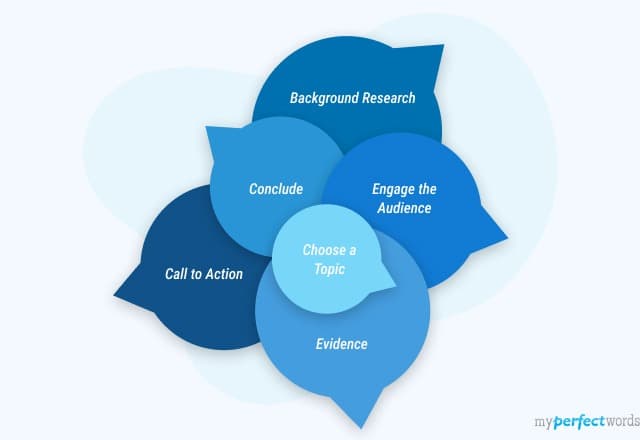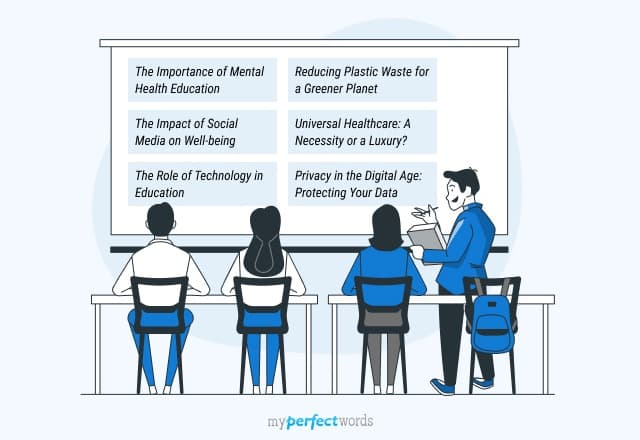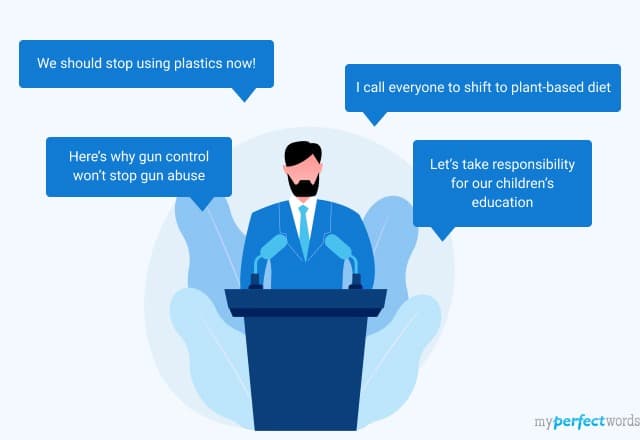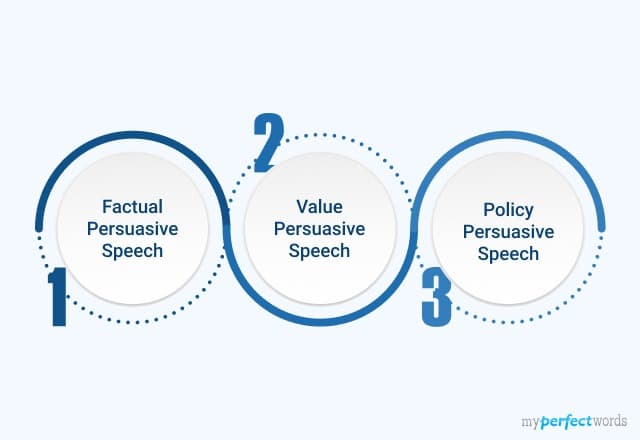
Have you ever been captivated by a persuasive speech that left a lasting impact? Persuasive speeches have the remarkable power to sway opinions, inspire action, and ignite change.
Students are often tasked with assignments to develop their persuasive communication skills. Creating an outline ensures you cover all necessary points and avoid repetition or confusion.
In this blog, we will not only provide you with a persuasive speech outline template but also offer valuable writing tips.
So, without further ado, let’s get right into it!
On This Page![]()
- 1. Components of a Persuasive Speech Outline
- 2. Persuasive Speech Outline Examples
- 3. Writing Tips for Creating Persuasive Speech Outlines
- 4. Mistakes to Avoid in Persuasive Speech Outlines
Components of a Persuasive Speech Outline
A persuasive speech aims to convince the audience of a specific point of view. Creating an outline helps in organizing thoughts and arguments.
It ensures that every point, supporting evidence, and counterarguments are considered and presented systematically.
Let's delve deeper into the components of a persuasive speech outline, specifically, the introduction, body, and conclusion.
Persuasive Speech Introduction Outline
The introduction of your persuasive speech is your opportunity to make a strong first impression and capture your audience's attention.
Its primary purpose is to set the stage for the speech and introduce the topic in an engaging way.
Here's how to craft an effective introduction:
- Hook Your Audience: Start with a hook that captures your audience's attention, like a quote, a shocking fact, a thought-provoking question, or a captivating story related to your topic.
- Thesis Statement: After the hook, clearly state your thesis statement, a concise, one-sentence declaration of your main argument or the central message of your speech.
- Overview of Main Points: End the introduction by briefly outlining the main points you'll cover in the body of your speech, giving your audience a roadmap of what to expect.
Let’s take a look at the example of this section in a speech:
Speech Topic: The Benefits of Regular Exercise Introduction Hook Did you know that more than 80% of American adults don't get enough exercise? Picture this: A few years ago, I struggled with low energy and frequent illness until I discovered the power of regular exercise. Thesis Statement Regular exercise offers a multitude of physical, mental, and emotional benefits that can significantly improve our overall quality of life. Importance of the Topic In today's fast-paced world, where many of us lead sedentary lives, understanding the advantages of regular exercise is essential for our well-being. Preview of Main Points In the following minutes, I will discuss the physical health benefits, the positive effects on mental well-being, and the emotional advantages of incorporating regular exercise into your daily routine. |
Persuasive Speech Body Outline
The body of your persuasive speech outline is where you present your main points and supporting evidence to make a compelling case for your argument.
Here's how to effectively organize and structure this section:
- Main Points: List your main arguments, with each one contributing to your overall message. Each point should be distinct and significant.
- Supporting Evidence: For each main point, provide supporting evidence, including facts, statistics, examples, expert opinions, or personal anecdotes that reinforce your arguments.
- Logical Organization: Arrange your main points logically, with the most persuasive ones coming first to guide your audience through your speech smoothly.
Let’s take a look at how this section will look in a speech:
Speech Topic: The Importance of Volunteering in the Community Body of the Speech Benefits of Volunteering for Individuals
Supporting Evidence: Studies have shown that individuals who volunteer regularly experience personal growth. They develop a greater sense of purpose and fulfillment in their lives. Volunteering provides an opportunity to step out of one's comfort zone and learn new skills, which, in turn, boosts self-confidence and self-esteem.
Supporting Evidence: Volunteering has been linked to improved mental health. Engaging in community service can reduce stress levels and alleviate symptoms of anxiety and depression. This is because it fosters a sense of belonging, social connection, and emotional well-being. When you help others, you also help yourself.
Supporting Evidence: Volunteering offers an ideal environment for skill development. Whether it's honing teamwork, leadership, communication, or problem-solving skills, volunteers gain practical experience that can benefit them personally and professionally. For example, many successful leaders credit their volunteer experiences for shaping their abilities. Impact on Community Development
Supporting Evidence: The act of volunteering strengthens social bonds within communities. By working together toward a common goal, volunteers build a sense of unity, trust, and shared purpose. This connectedness contributes to the overall well-being and resilience of the community.
Supporting Evidence: Volunteering addresses specific local needs and issues. Community volunteers often play a vital role in solving problems, be it by participating in neighborhood clean-ups, tutoring students, or distributing food to the less fortunate. Their efforts have a direct and positive impact on the lives of community members.
Supporting Evidence: Many volunteer initiatives result in long-lasting improvements in communities. Projects like reforestation efforts, urban renewal, and literacy programs have made a significant and enduring impact. The commitment of volunteers to sustained change illustrates the potential for individuals to be catalysts for transformation. |
Persuasive Speech Conclusion Outline
The conclusion of your persuasive speech outline serves the crucial role of bringing your speech to a memorable and impactful close.
Here's how to craft an effective conclusion:
- Restate Thesis and Main Points: Start the conclusion by restating your thesis and summarizing your main points to remind your audience of your key arguments.
- Compelling Closing Statement: End with a compelling closing statement, such as a thought-provoking remark, a call to action, a rhetorical question, or a memorable quote that ties back to your topic and leaves your audience pondering.
Here is how it will look in the speech outline:
Speech Topic: The Importance of Volunteering in the Community Conclusion Restate Thesis In summary, volunteering isn't just a choice; it's a vital component in building compassionate, united, and resilient communities. Summary of Main Points Throughout this speech, we've explored the personal benefits of volunteering, its positive impact on community development, and ways to get involved in community service. Closing Statement As we conclude, remember that your contribution can change lives and communities. So, let's make a commitment to volunteer and be the positive change our communities need. By giving our time and effort, we can create a stronger, more compassionate world for ourselves and future generations. |
Persuasive Speech Outline Examples
Let’s take a look at an example of a persuasive speech outline to give you a better idea of the structure:
The Topic of Speech: The Importance of Recycling I. Introduction
II. Environmental Impact of Recycling
Supporting Evidence: Recycling reduces the burden on landfills and prevents the release of harmful chemicals into the environment.
Supporting Evidence: Recycling conserves valuable resources like trees, water, and minerals.
Supporting Evidence: The recycling process consumes less energy compared to producing items from raw materials. III. Economic Advantages of Recycling
Supporting Evidence: Recycling programs create jobs in collection, processing, and manufacturing.
Supporting Evidence: Recycling reduces production costs and waste disposal fees for businesses.
Supporting Evidence: Selling recyclable materials generates revenue for local governments. IV. The Role of Individuals in Recycling
Supporting Evidence: Simple steps like separating recyclables from trash at home can have a big impact.
Supporting Evidence: Encouraging communities to participate in recycling programs fosters a sense of responsibility.
Supporting Evidence: Advocating for recycling through education and community initiatives can create a culture of recycling. V. Conclusion
|
Here are some amazing outline examples that you can refer to ensure you are on the right track:
Check out more persuasive speech examples to have a better idea of structuring your speech!
Writing Tips for Creating Persuasive Speech Outlines
When it comes to delivering a persuasive speech, the foundation of your success lies in your speech outline.
Here are some writing tips to help you create a compelling and persuasive speech outline:
- Choose a Topic of Your Interest:
Select a persuasive speech topic that genuinely interests and inspires you as it will make your speech more persuasive.
- Address Controversy or Debate:
Topics that involve controversy or ongoing debates often make for persuasive speeches. Presenting different viewpoints and then arguing for your perspective can engage your audience and make your speech more compelling.
- Consider Your Audience:
Think about your target audience's interests, beliefs, and values. Your topic should resonate with them. Tailor your message to address their concerns and align with their perspectives.
- Focus on a Clear and Specific Issue:
A well-defined and specific topic is more persuasive than a broad or vague one. Narrow down your subject to a particular issue or aspect that you can thoroughly address within the allotted time.
- Research and Gather Information:
Ensure that there is enough credible information available on your chosen topic. A well-researched speech with supporting evidence is more persuasive.
Mistakes to Avoid in Persuasive Speech Outlines
While crafting a persuasive speech outline, it's equally important to be aware of common mistakes that can hinder your effectiveness.
Avoiding these common mistakes will help you create a more persuasive and engaging speech:
- Lack of Clarity:
Ensure that your outline defines your main goal and message, making it easy for your audience to understand your intent.
- Overloading with Information:
Providing too much information can overwhelm your audience. Stick to the key points and avoid overwhelming your listeners with excessive data, details, or statistics.
- Weak or Generic Introduction:
A lackluster or generic introduction can fail to capture your audience's attention. Aim for a strong and engaging start that piques the interest or emotions of the audience.
- Neglecting Counterarguments:
Ignoring opposing viewpoints can make your speech appear one-sided. Address counterarguments and offer strong counterpoints to strengthen your position and credibility.
- Ignoring Your Audience's Perspective:
Ensure that your speech addresses their needs and concerns, making it more relevant and persuasive to them.
So there you have it!
We have discussed the components of a persuasive speech outline in detail.
By following the tips we've covered in this blog, you can create persuasive speech outlines that are well-structured and engaging.
The introduction, body, and conclusion work together to grab your audience's attention, make your points convincingly, and leave a strong impression.
However, if you still need help writing your speech, you can get help from professional writers at MyPerfectWords.com.
MyPerfectWords.com is a paper writing service that you can rely on. Our writers are experts at crafting proper speech outlines and writing compelling speeches.
So, why wait? Buy speech at the cheapest prices today!

Write Essay Within 60 Seconds!
Use our AI tool to generate high quality essay
WRITTEN BY
Cathy A.
Cathy has been been working as an author on our platform for over five years now. She has a Masters degree in mass communication and is well-versed in the art of writing. Cathy is a professional who takes her work seriously and is widely appreciated by clients for her excellent writing skills.
Keep reading
Making Persuasive Speech Writing Easy: Steps and Tips

Good Persuasive Speech Topics & Ideas for Debaters

Top Motivational Speech Topics and Ideas

16 Best Persuasive Speech Examples for Students

3 Basic Types of Persuasive Speeches

